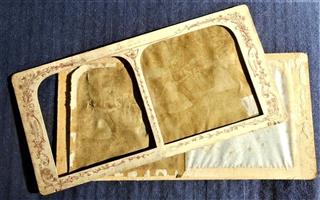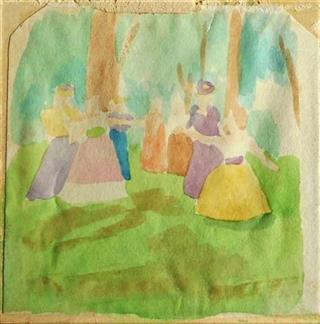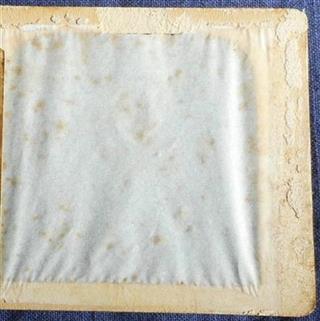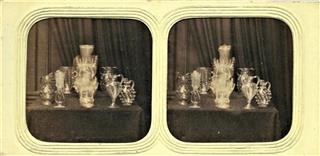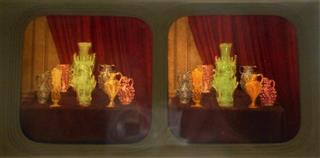FRENCH TISSUE STEREOVIEWS
French “hold-to-light” tissue views were popular in the 1860s-1870s.
They are very special photographs which use to great advantage the
properties of albumen paper. The majority of 19th-century photographs
were printed on albumen paper had a sensitive emulsion made using egg
whites. The resulting paper is very thin and needs to be mounted on a
strong cardboard backing to prevent it from tearing or curling. The
French discovered that if albumen photos were placed in a stereo card
mount with openings cut revealing only the images, that with some
manipulation they could create special effects..
read more...
Jump to
Images:
Tissues and
Surprise Tissues
|
|
[illus. 1]. Their invention was to create a “sandwich” consisting of two cardboard mounts with cut-out openings, in the middle of which are two layers
|
|
|
[illus. 2]. The first layer is an albumen photograph which has been modified. For example, colors were painted on the backs of the photos |
|
|
[illus. 3]. This tinting is then hidden by a second thin piece of tissue paper, and the back mount added completing the sandwich |
|
|
[illus. 4], When viewed from the front with reflected light, the stereo appears like any other photograph |
|
|
[illus. 5] But, when backlit, MAGIC happens! |
Scenes with sepia tones become wonderfully tinted. At the time these
were made, color photography did not exist--it could only be obtained by
hand tinting. The creators of tissue views were not only artists, they
had other tricks up their sleeves. Frequently tiny holes were pierced in
the albumen paper. With backlighting these became sparkling jewels, or
stars, or tiny lights, or even glowing eyes! Other times the fragile
paper was embossed which produces a gentle glow. Soon after the French
introduced tissues, other countries, especially England, started to
produce these wonderful creations.
The very best tissues to my mind, however, were those that provided
viewers with surprises which could only be seen when backlit. They are
known as “surprise tissues”, and they took far more time to create. When
tinting the backs of the albumen paper, figures etc. might be added that
were not in the photograph. People would appear out of nowhere, or
balloons, or ships, or who knows what. Cutouts were made in the shape of
flames, and a special red gel was added so that buildings would appear
to burst into fire, or fireworks would explode. Embossing helped to
create comets streaking through the sky, or accent fragile ruffles on a
dress. There was no end to their creativity.
One can easily be inspired to try and create tissue views today. We
spent nearly a year attempting to do just that. Our best efforts could
be described as only miserably acceptable. Modern paper does not have
the same characteristics of albumen paper. That is to say, for tissue
views to work properly there must not be any hint of what will happen
when they are lit from the back. All of the paper stock we tried (and we
tried everything we could get our hands on), or even made, was either
too transparent and revealed too much, or was not sufficiently
translucent for the special effects to show through. The only solution
so far appears to be obtaining extremely expensive, handmade albumen
paper. One need not worry about modern fake tissue views. If you find a
tissue view, it’s almost certainly an antique.
There is a further problem with these lovely tissue views—they are the
deuce to photograph or scan. Front lighting is no problem, but getting a
good backlit photo requires that the viewer’s side of the view be dark
with light coming only from a source behind the tissue. It probably
doesn’t come as a surprise (no pun intended), that the best light
sources are sunlight or candles—the same lights that 19th century
viewers would have had. This note about the difficulties of
photographing is by way of an apology for the quality of some of the
views shown here.
So -- why post these charming images on my website? There are several
reasons. Given the very fragile nature these views, and the fact that
they are 150-160 years old, surviving examples are rare. High quality
surprise tissues, even more so. Further, publishing surprise tissues in
a traditional book form it neigh on impossible. Admittedly the
publication “Paris in 3D: From Stereoscopy to Virtual Reality 1850-2000”
includes a very successful demonstration of a tissue view, but it
involves special paper construction like a pop-up book, multiple layers,
and precise positioning. This is extremely expensive to do which is why
only one such view is illustrated. Another option is to photograph the
tissues under front and back lighting, and then publish them as two
separate views, but this means there is no element of surprise. What fun
is that? Posting them online however, does allow the viewer to
experience the magic of the special reveal. And lastly, they are here
simply because I love them and they provide a fun break from all of the
documentary data in the rest of this website.
Thus, purely for your viewing pleasure, I am posting a selection from
our collection of tissue views. The first part illustrates regular
tissues. These have gorgeous tinting, piercing, etc. Some are even
tinted on the front which is very rare. Also included in this section
are a selection of amusing views called, “Diableries”. In addition to
their being just plain fun (ice skating in hell, e.g.), they are
beautifully tinted with bright cut-out flames, and many of the minions
even have glowing eyes. Brian May and Denis Pellerin and I published a
book about them. To get a taste of their devilishness, please see our
paper, “Diableries-
Stereographic Adventures in Hell”, reproduced here in the
Published Papers
section.
The second part of tissue views are those wondrous views with special
effects. All you have to do to create the magic is anticipate what the
surprise might be, then hover your mouse over the images for back lit
versions and SURPRISES will appear! I hope you enjoy them.
Jump to Images: Tissues and Surprise Tissues
